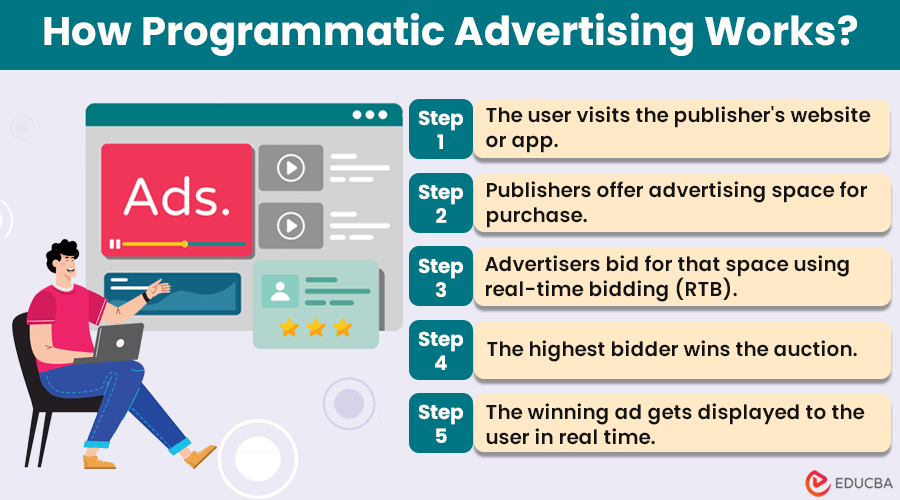What is Programmatic Advertising?
Programmatic advertising uses auction-based software to simplify the purchasing and selling of digital advertising space or inventory (such as on websites or applications) in real time.
In simple words, programmatic advertising is a smart software that helps businesses show an advertisement to the right user at the right time. Here, instead of humans negotiating deals with advertisers and deciding which ads to put, computers use customer’s data and algorithms to figure out the best ads to show them.
Nowadays, there are various means of digital advertising techniques. However, programmatic plays a key role in reshaping the digital advertising industry with its ability to automate buying, optimizing, and placing advertisements. In this blog, we will explore the future of programmatic advertising in reshaping digital advertising and its components and working.
Table of Contents
Components
The following are the key components of programmatic advertising.
1. Publishers
Publishers in programmatic advertising are individuals or companies that own websites, online magazines, mobile apps, social media platforms, or other digital platforms. They offer advertising space, known as ad space or ad inventory, for advertisers to display their ads.
2. Advertisers
Advertisers are individuals, businesses, or organizations that buy those ad spaces from publishers to promote their products, services, or brands.
3. Demand-Side Platform (DSP)
DSPs let advertisers automatically buy or purchase digital ad space across multiple ad exchanges. DSP helps advertisers determine which ads to publish at what price. It also helps manage their campaign ads based on the target audience’s demographics, browsing history, and more.
4. Supply-Side Platform (SSP)
SSPs are platforms publishers use to sell (offer) their available ad space or inventory for purchase. SSPs usually connect publishers with multiple ad exchanges and ad networks, allowing them to sell their inventory to the highest bidder.
5. Ad Exchanges
Ad exchanges are online platforms where publishers and advertisers meet to sell and purchase ad spaces using real-time bidding. When an ad inventory becomes available, advertisers bid with others, and the highest bidder gets the chance to display their ad on the publisher’s site.
6. Data Management Platforms (DMPs)
DMPs gather data from various sources, including website visits, social media interactions, and third-party data providers, to create detailed audience profiles. It helps advertisers better understand their target audience and optimize their targeting strategies.
How Does it Work?
Let’s understand how programmatic advertising works with the help of the following steps.
#1: When a user visits a website or uses an app with space reserved for advertisements, i.e., ad space, the website sends a request to load an advertisement.
#2: Publishers who own the websites or apps make this ad space available for purchase to potential advertisers through a supply-side platform (SSP).
#3: Advertisers analyze user’s data using demand-side platforms (DSP) to understand their preferences, browsing history, and demographics on the publisher’s website or app. Also, they set their bidding parameters, such as the maximum amount they are willing to pay.
#4: Ad exchanges, sometimes SSP, organize auctions for potential advertisers using real-time bidding (RTB). Here, advertisers bid in real-time for the available ad space based on their campaign goals and target audience.
#5: The highest bidder wins the auction, and their ad is selected to display on the publisher’s website or app. This happens in real time as the webpage or app loads.
To conclude, the publisher earns revenue from the winning bid, and the amount depends on the demand for their ad space and the competition.
Future Trends in Programmatic Advertising
Now, you might have understood the meaning of programmatic advertising and how it works. But the question is, “What is the future of programmatic advertising in digital advertising?”
As technology continuously evolves, the future of programmatic digital advertising looks promising. Since it is a popular medium for publishers and advertisers to connect, it gives them important data to understand their digital marketing campaigns.
Here are some key trends of programmatic advertising shaping the future of digital advertising.
1. Video Programmatic Advertising
Video is a powerful digital advertising tool as it conveys brand information better in a visual format. Advertisers will be able to use short videos to connect with their target audience.
2. Contextual Advertising
In digital advertising, contextual advertising is a new emerging method of advertising. In contextual advertising, the advertiser will display ads relevant to the website content, not the user’s behavior.
3. AI and Machine Learning
Machine learning and AI (artificial intelligence) are essential in programmatic advertising. They enable advertisers to analyze customer data, like predicting consumer behavior, to optimize personalized campaigns in real-time for maximum effectiveness.
4. Cross-Channel Integration
Suppose a user watches an ad on a particular website on their computer and opens it on their smartphone; the programmatic technology should also be able to display a similar ad on the smartphone. This is cross-channel integration in programmatic advertising. This will enable advertisers to create cohesive and personalized consumer experiences across multiple touchpoints.
5. Privacy and Data Protection
Privacy and data protection standards are according to GDPR and the California Privacy Act. Advertisers must prioritize transparency about collecting, using, and storing consumer data to maintain trust and credibility with their audiences. This helps to build trust with consumers.
Final Thoughts
In conclusion, programmatic advertising is reshaping the future of digital advertising in profound ways. Although programmatic provides several benefits, it is also necessary for advertisers and publishers to look into challenges. Moreover, as digital advertising evolves, staying updated with the latest trends in programmatic advertising will be essential to drive results in an increasingly competitive marketplace.
Recommended Articles
We hope this article on “Programmatic Advertising” was informative and helpful. To learn more about related topics, refer to the articles below.



